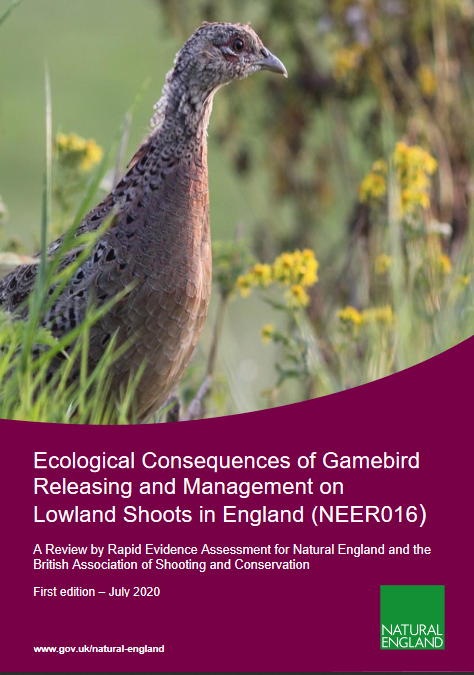The DEFRA/NE/BASC/GWCT/Exeter University review of released gamebird impacts
This review forms a major part of DEFRA’s response to our legal challenge over the impacts on sites of high conservation importance of unregulated releases of tens of millions of non-native gamebirds. It was commissioned last autumn, appears to have been completed this spring but was only published last week, in late summer (over a year after our legal challenge started).
Wild Justice’s position on the science is that because this review does not rule out ecological impacts then DEFRA should act as though such impacts exist until it has done the necessary work to investigate further. Lack of proof for an impact cannot be taken as proof for lack of an impact, particularly where there is evidence that such an impact is entirely feasible.
And that, essentially, is where we think the science leaves DEFRA – not being able to discount impacts of exactly the sorts that the Wild Justice challenge identified. We’ll have to leave it to the lawyers to figure out where we go from here but if DEFRA had hoped to put a line through all of our concerns then this review doesn’t do that.
Overall quality of, and findings of, the review
We regard this as a sound piece of work. It comes to essentially the same conclusions that everyone else does, that there are some potentially harmful impacts of releasing very, very large numbers of non-native birds into the countryside, these are not foolish concerns but because they have not been studied in great detail their magnitude is unknown – unknown, not nonexistent. In other words they might be big impacts and that possibility has not been ruled out. Moreover, the more birds that are released the greater these impacts will be.
We do not mean to disparage this review by saying this, but it hasn’t moved knowledge on very much. The view expressed in the paragraph above could probably have been agreed over a couple of pints in a pub by the authors of this review, Wild Justice, GWCT and a bunch of ecologists. DEFRA, NE and others have spent the last year confirming what we all knew a year ago.
Limitations with this review
This review is a sound piece of work but its value to DEFRA in addressing the science of the Wild Justice legal challenge is somewhat limited. This is partly because of the scope of the review (which was presumably decided by DEFRA and Natural England (and perhaps, bizzarely, BASC) rather than by the authors).
To recap, Wild Justice says that millions of released gamebirds (Pheasants and Red-legged Partridges) are likely to have impacts on Natura 2000 sites (Special Protection Areas for Birds and Special Areas of Conservation) which need to be assessed. These impacts include physical impacts of trampling, grazing, eating of invertebrates, removal of seed resources otherwise available to wild native species, increases in predator and scavenger populations (eating live or dead gamebirds), increased fertiliser input of defecating gamebirds, increases in persecution of birds of prey and increased use of lead shot.
Because gamebirds move around, and Wild Justice has already demonstrated that Pheasants and/or Red-legged Partridges are found on all Natura 2000 sites or in their very close neighbourhood, then all Natura 2000 sites are potentially affected by gamebird releases. We are not concerned with sites on which gamebirds are released, we are concerned with sites on which released gamebirds occur, and not just lowland sites but all sites as was eminently clear in our legal papers (which the authors of this review may well not have seen) which have been with DEFRA for months and months.
So, some headline limitations with this review include:
- very little attention has been paid to upland sites (this is a bit odd in that we know from BTO data that Pheasant numbers have increased more rapidly in upland areas)
- there is very little attention given to Red-legged Partridges (presumably because more of the literature is on Pheasants)
- there is no analysis of impacts specifically on SPAs and/or SACs (and yet that is the focus of our legal challenge)
- the impacts of lead ammunition use on shoots is not covered (presumably because it is embarrassing to DEFRA that a very thorough review of ecological (and health) impacts of lead ammunition use was provided to DEFRA in 2015 which recommended phasing out of lead ammunition and this has never been implemented by DEFRA).
- the authors say they can’t find any link between gamebird releases and raptor persecution incidents but, as they must know, there is no complete database of raptor persecution incidents for them to use in analysis. (The authors have ignored the fact that the great majority of convictions for crimes against birds of prey are by people whose jobs are associated with gamebird shooting).
These are fairly significant limitations. However, we accept that the major limitation is not the fault of the authors nor solely the fault of the commissioners of this review, and that limitation is that the necessary studies have not been carried out.
There are several studies which show that at high densities, often in or near release pens, gamebirds have detrimental impacts on vegetation or invertebrate biomass. These are important because if they had shown no impact at all then that would be strong evidence for no harmful impact. However, because at high densities there is a discernible impact then, biologically, we must assume that there is a more widespread but lower impact when all those gamebirds are released to roam around over a larger area. They do not stop eating invertebrates, pecking at vegetation or defecating for the months that they are outside of the release pens it is just that any impacts are spread over a much wider area and for a much longer period of time.
So, Wild Justice’s concerns are confirmed and endorsed by this review. What will DEFRA do as a result?
There are other quibbles we have with this review, which we may add in here as time goes on and on re-reading of the work.

